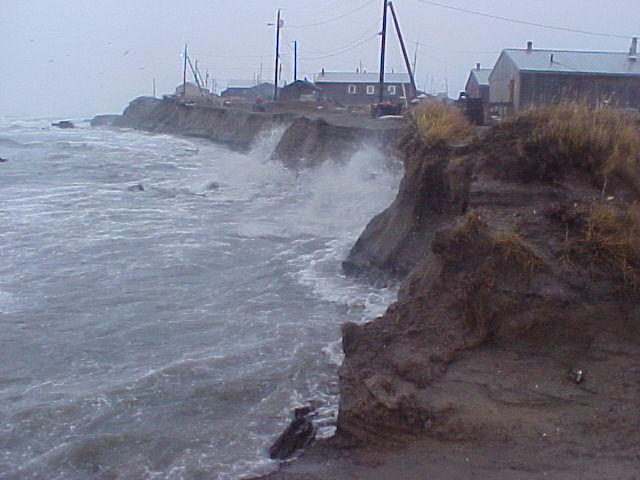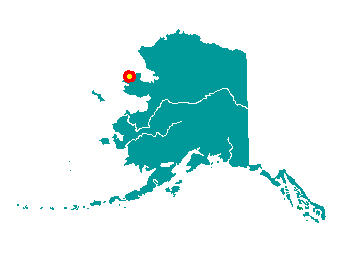Originally published on EdenKeeper.org

Retreating onto the uncharted territory of today’s “climate refugees,” the entire indigenous community of Shishmaref, Alaska, is losing the land under its feet. Shishmaref has a population of around 600 members of the Native American Inupiat Tribe, located on Sarichef, a tiny island north of the Bering Strait.
For over 400 years, this austere, ice-bound Arctic environment has provided home and subsistence for Shishmaref’s community. But now, the forces of climate change are transforming the entire population into climate refugees.
Land is Disappearing Under the Feet of Climate Refugees
Heavy sea ice once shielded the tribe from powerful storm surges, but ice thawing due to global warming is leaving the island vulnerable to heavy coastal erosion. The permafrost layer of frozen soil upon which the community is built is also melting under the residents’ feet.
With few alternatives to protect themselves from flooding and shoreline erosion, the people are losing homes and buildings with every new storm, and up to ten feet of shoreline each year.
 On an island of only seven square miles, time is no longer on the side of Shishmaref’s Inupiat Tribe.
On an island of only seven square miles, time is no longer on the side of Shishmaref’s Inupiat Tribe.
There have been numerous attempts to evade the inevitable fate of Shishmaref’s sinking island. Votes to relocate have been held since as early as 1972, and also in 2002. But efforts to find a suitable new home for the climate refugees have failed, time after time.
Previous funding problems have also lately been superseded by soil findings rendering all previously chosen sites unacceptable. However, with new analysis performed last February by AECOM for the state government in Alaska, several potential sites have been identified and deemed acceptable.
Community Protections are Only Temporary
With assistance from the US Army Corps of Engineers and other agencies, protective seawalls were constructed between 2005 and 2009. The National Guard Armory and several homes were moved away from the shore, as well. The costs were over $27 million, and unfortunately, the lifespan expectancy of this protection is only 15 years.
Once again voting over whether or not to relocate, a community vote taken last week was split 89 to 78 in favor of moving. The official count has not yet been formally announced, and absentee ballots are reportedly not yet opened.
Lutheran Pastor Tommy Richter leads Shishmaref’s only church. He reported that the entire community is torn over leaving its heritage behind. He added, “There are people here who have been here for generations and don’t want to leave at all.”

Relocating Will Not be Quick or Easy
Two important considerations for moving the Shishmaref climate refugees include transportation needs by both boat and airplane. Travel by boat is the main mode of transportation for residents. The water also provides essential access for hunting sea and land mammals that the people rely upon for subsistence. Barges deliver fuel and goods to the community as well, during the open water season.
The Shishmaref community also relies upon their airport for receiving freight and visitors. Daily connections to Nome, Alaska, keep the community connected to the outside world throughout the year.
Even when everything is finally agreed upon, relocating the Shishmaref climate refugees will not be quick or easy. AECOM anticipates that moving existing private and public buildings, water and sewer infrastructure, power and lighting infrastructure, airport and runway, vehicles, boats, docks and barge landing, etc., will take years to accomplish. Everything must be disassembled and barged across the Shishmaref Inlet to the site ultimately chosen.
The chosen site, as well, will need a new barge landing to receive the goods, and access roads must be developed upon which everything will be transported. The site itself will require appropriate development prior to the reconstruction of properties, infrastructure, and new airport facilities.
Seeking Funds to Help Defend Against Global Warming
With costs for relocating Shishmaref estimated at around $180 million, agency and community officials are seeking state and federal funding. Last spring, $6.5 million in funding was announced by the US Dept. of the Interior. This money will be very helpful for Native American communities fighting the effects of global warming on their traditional ways of life.
Over 140 tribes and tribal organizations have already received funding since 2014 to help defend against global warming impacts.
Several other US communities are facing inevitable status as climate refugees, including other locations in Alaska, Washington, and Louisiana. Christina DeConcini, a spokesperson for World Resources Institute in Washington, DC, states that several other communities are also weighing options to move.
DeConcini notes, “It’s not going to be the last time that the United States has to deal with communities severely threatened by climate change and impacts and whether or not they can stay there.”
[Top image: Shishmaref shoreline erosion is turning native inhabitants into climate refugees. Credit: Tony Weyiouanna, Commerce.Alaska.gov]